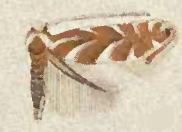The supposed American Elm cultivar Ulmus americana 'Pyramidata' was a Belgian clone listed by Wesmael in Bulletin de la Fédération des sociétés d'horticulture de Belgique, 1862, as Ulmus Americana pyramidalisHort.. It was marketed by the Baudriller nursery, Angers, France, and appeared in their catalogue of 1880 as U. Americana pyramidata. Wesmael's Ulmus americana and Ulmus americana var. variegata, however, do not appear from herbarium specimens to have been American white elm. It is known that nurseries in Europe and America marketed the golden wych elm Ulmus glabra 'Lutescens' as Ulmus americana aurea, so it is possible that Wesmael's Ulmus americana pyramidalis was similarly misnamed.
The so-called American Elm cultivar Ulmus americana 'Variegata' was a Belgian clone mentioned by Wesmael in Bulletin de la Fédération des sociétés d'horticulture de Belgique, 1862, as Ulmus americana var. variegataHort. It was marketed by the Baudriller nursery of Angers as U. americana foliis variegatis. Wesmael's herbarium specimens, however, held in the Botanic Garden, Meise, both of his Ulmus americana and of his Ulmus americana var. variegata, do not appear to show American white elm leaves. It is known that nurseries in Europe and America marketed the golden wych elm Ulmus glabra 'Lutescens' as Ulmus americana aurea, and it is likely that Wesmael's Ulmus americana variegata was similarly misnamed, and perhaps derived from a reverting branch of aurea, whose leaves it resembled.
The hybrid elm cultivar Ulmus 'Hamburg' was originally raised by the Plumfield Nurseries, Fremont, Nebraska, circa 1932, after its discovery by Mr. Lloyd Moffet in a bed of Siberian Elm Ulmus pumila seedlings from Tekamah. It was later marketed by Interstate Nurseries, Hamburg, Iowa, in 1948, and claimed to be a hybrid of Ulmus pumila and Ulmus americana. However it is now considered more likely that Ulmus rubra was the male parent.

The American elm cultivar Ulmus americana 'Pendula' was originally listed by William Aiton in Hort. Kew, 1: 320, 1789, as U. americana var. pendula, cloned in England in 1752 by James Gordon. From the 1880s the Späth nursery of Berlin supplied a cultivar at first listed as Ulmus fulva (Michx.) pendulaHort., which in their 1899 catalogue was queried as a possible variety of U. americana, and which thereafter appeared in their early 20th-century catalogues as U. americana pendula. The Scampston Elm, Ulmus × hollandica 'Scampstoniensis', in cultivation on both sides of the Atlantic in the 19th and 20th centuries, was occasionally referred to as 'American Weeping Elm' or Ulmus americana pendula. This cultivar, however, was distinguished by Späth from his Ulmus americana pendula.
Stigmella kazakhstanica is a moth of the family Nepticulidae. It is found in Astrakhan, Kazakhstan and Turkmenistan.
Phyllonorycter acaciella is a moth of the family Gracillariidae. It is found in southern Europe, but not on the Iberian Peninsula and Balkan Peninsula.
Phyllonorycter agilella is a moth of the family Gracillariidae. It is found in Latvia central Russia, Pyrenees, Italy and Bulgaria and from France to eastern Russia.
Phyllonorycter brunnea is a moth of the family Gracillariidae. It is known from the island of Rhodes in Greece.

Phyllonorycter tristrigella is a moth of the family Gracillariidae. It is known from all of Europe, except the Iberian Peninsula and the Balkan Peninsula, east to the European part of Russia. It was also recorded from Japan, but this is a misidentification of Phyllonorycter laciniatae.

Phyllonorycter schreberella is a moth of the family Gracillariidae. It is known from Europe, except northern Europe, Ireland and the Balkan Peninsula.
Phyllonorycter ulmi is a moth of the family Gracillariidae. It is known from Japan, Korea and the Russian Far East.
Phyllonorycter bicinctella is a moth of the family Gracillariidae. It is known from Hokkaido island of Japan and the Russian Far East.
Phyllonorycter laciniatae is a moth of the family Gracillariidae. It is known from Hokkaidō island of Japan and from the Russian Far East.
Caloptilia ulmi is a moth of the family Gracillariidae. It is known from China, Japan and the Russian Far East.

Phyllonorycter argentinotella is a moth of the family Gracillariidae. It is known from Québec in Canada and Illinois, Kentucky, Pennsylvania, New York, Vermont, Connecticut and Massachusetts in the United States.
Phyllonorycter occitanica is a moth of the family Gracillariidae. It is known from Texas, United States.

Cameraria ulmella is a moth of the family Gracillariidae. It is known from Ontario and Québec in Canada, and Texas, Kentucky, Maine, Maryland, Michigan, New York, Georgia, Illinois and Connecticut in the United States.
Phyllonorycter pumilae is a moth of the family Gracillariidae. It is known from the Russian Far East, Japan and north-western China.
Bucculatrix caspica is a moth in the family Bucculatricidae. It was described by R. Puplesis and V. Sruoga in 1991. It is found in Kazakhstan, Uzbekistan, Tadjikistan and the southern part of European Russia. It is most likely a synonym of Bucculatrix ulmifoliae.
Ulmus × intermediaElowsky is a natural hybrid elm occurring across Nebraska and several other Midwestern states, derived from the crossing of Ulmus rubra and Ulmus pumila. As Red Elm U. rubra is far less fertile, and highly susceptible to Dutch elm disease (:DED), it could eventually be hybridized out of existence by U. × intermedia. The hybrid was first reported from the wild in the Chicago region in 1950 and was provisionally named U. × nothaWilhelm & Ware in 1994.

